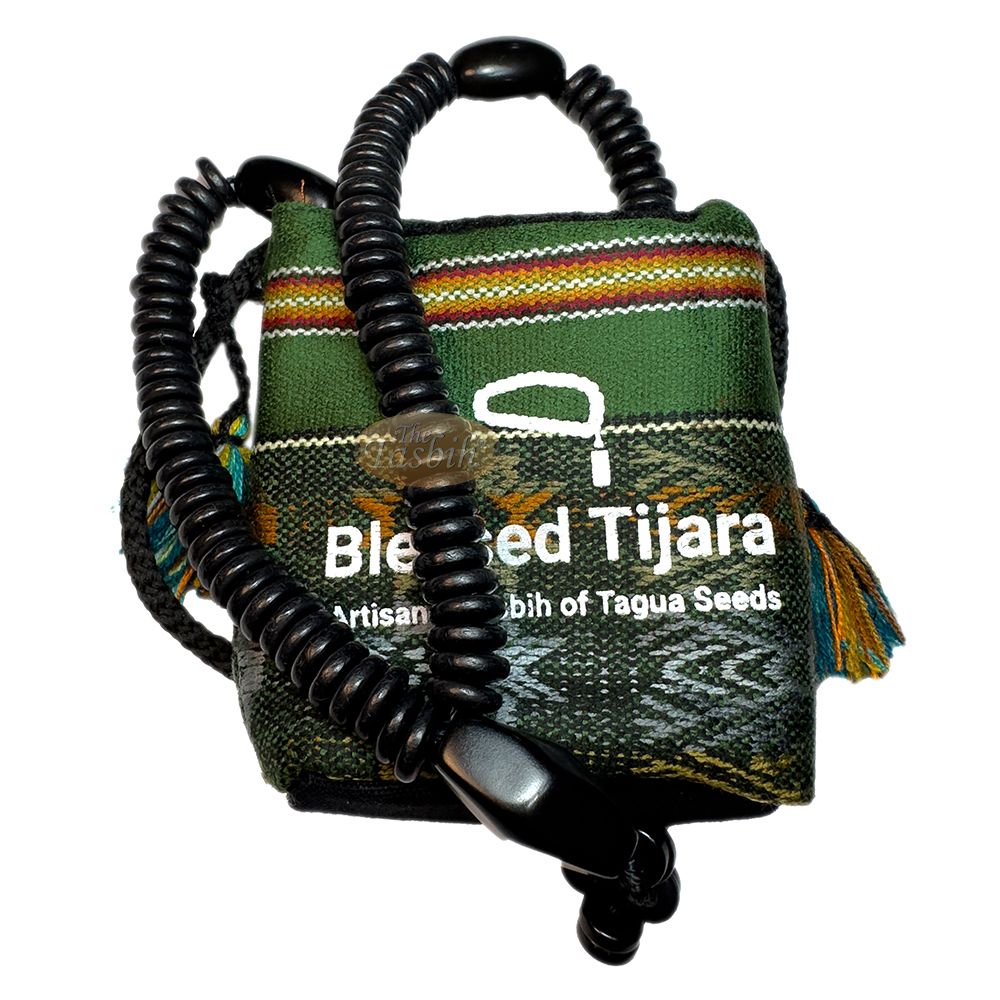Black Tagua Disk Bead Tasbih
Black Tagua Disk Bead Tasbih
Low stock: 1 left
Couldn't load pickup availability
SKU: TJR-TTBLK

- Description
- Details
The Enchanting Elegance of Vegetable-Dyed Tagua Tasbihs: A Fusion of Nature's Beauty and Spiritual Serenity In an era characterized by rapid technological advancements and urbanized lifestyles, there's an increasing quest for balance and connection to nature. This quest extends beyond physical surroundings to encompass even our personal belongings, such as accessories with spiritual significance. Among these, the Tagua tasbih strands out as a remarkable embodiment of spirituality and ecological awareness, especially when adorned with colors derived from vegetable dyes. This article explores the qualities and advantages of the Tagua tasbih colored with vegetable dyes, elucidating its allure as a harmonious fusion of nature's beauty and spiritual serenity. Qualities of the Tagua Tasbih Colored with Vegetable Dyes: Eco-Friendly and Sustainable: The use of vegetable dyes for coloring Tagua tasbihs aligns seamlessly with the global movement towards sustainability. These dyes are sourced from natural materials like leaves, roots, fruits, and flowers, reducing the ecological footprint associated with chemical dyes. By opting for vegetable-dyed tasbihs, individuals contribute to a more sustainable and planet-friendly way of living. Vibrant and Authentic Colors: Vegetable dyes yield a distinct range of hues that are often softer and more authentic in appearance. These colors resonate with the organic world, evoking a sense of connection to nature. Each hue carries its own significance, making vegetable-dyed tasbihs a personalized embodiment of spirituality and self-expression. A Connection to Tradition: Tasbihs hold deep cultural and religious significance in various spiritual traditions. By choosing a Tagua tasbih colored with vegetable dyes, individuals not only honor their religious heritage but also align with traditional methods of dyeing that have been practiced for centuries. Smooth and Polished Texture: Tagua nuts, also known as "vegetable ivory," possess a naturally smooth and polished surface. When coupled with vegetable dyes, the resulting tasbihs offer a tactile experience that's soothing to touch. This sensory aspect enhances the overall meditation and prayer experience, fostering a sense of tranquility. Enhanced Aesthetics: Vegetable dyes infuse Tagua tasbihs with a unique visual appeal. The colors meld seamlessly with the natural grain and texture of the tagua nut, creating a harmonious blend that's aesthetically pleasing. These tasbihs can serve as artistic pieces, not just functional items, enhancing one's personal space. Symbolism and Significance: Each color derived from vegetable dyes carries its own symbolism in different cultures and belief systems. By selecting specific hues, individuals can imbue their tasbihs with personal meaning and intent. This adds a layer of depth to the spiritual practice, allowing practitioners to resonate with the symbolism of their chosen colors. Advantages of the Tagua Tasbih Colored with Vegetable Dyes: Spiritual Enhancement: The act of prayer and meditation is deeply personal and often relies on the practitioner's ability to connect with their inner self and the divine. Vegetable-dyed Tagua tasbihs act as conduits, facilitating this connection through their tactile and visual qualities. The use of natural colors further enhances the spiritual experience, helping individuals find serenity and focus. Mindful Living: Incorporating items made from natural materials and colored with vegetable dyes into daily life fosters a sense of mindfulness. These tasbihs serve as reminders of the interconnectedness between humans and nature, prompting individuals to lead more conscious and intentional lives. Ethical Consumption: Choosing vegetable-dyed tasbihs supports ethical consumer choices. By opting for products that are created using sustainable methods and materials, individuals contribute to a market demand for environmentally friendly products, encouraging more businesses to adopt eco-conscious practices. Cultural Reverence: In cultures where tasbihs are revered as sacred objects, using a vegetable-dyed Tagua tasbih signifies a deep respect for both spiritual traditions and the natural world. This amalgamation of culture and nature underscores the interconnectedness of humanity's diverse beliefs and the universal reverence for Earth. Personal Expression: The customization options offered by vegetable-dyed tasbihs allow individuals to express their unique identities. Choosing colors that resonate with personal experiences, aspirations, or emotions transforms these tasbihs into intimate reflections of the self. Contribution to Artisan Livelihoods: Many vegetable-dyed Tagua tasbihs are crafted by skilled artisans, often from marginalized communities. By supporting these artisans, individuals contribute to the preservation of traditional crafts and help uplift livelihoods, ensuring the continuation of rich cultural heritage. In Conclusion: The Tagua tasbih colored with vegetable dyes is more than just a string of prayer beads; it's a harmonious fusion of nature's beauty and spiritual serenity. Its eco-friendly qualities, vibrant hues, and symbolism create a deeply enriching experience for practitioners. By choosing these tasbihs, individuals weave threads of tradition, sustainability, and personal expression into their spiritual practice, fostering a holistic connection with the self, the divine, and the natural world. As we navigate the modern world's complexities, the simplicity and authenticity of vegetable-dyed Tagua tasbihs offer a path towards balance and tranquility.
Key Features
- Natural colored
- Handmade traditional tasbih
- Eco-friendly tasbih
- Made in South America
- Unique artisanal tasbih
| Brand | Blessed Tijara |
| Color | Black |
| Material | Wood |
| Wood Type | Tagua |
| String Color | Black |
| Weight | 100 g |


